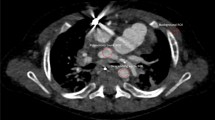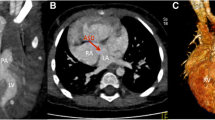Abstract
Objectives
To compare accuracy, image quality and radiation dose between high-pitch spiral and sequential modes on 128-slice dual-source computed tomographic (DSCT) angiography in children with congenital heart disease (CHD).
Methods
Forty patients suspected with CHD underwent 128-slice DSCT angiography with high-pitch mode and sequential mode respectively. All the anomalies were confirmed by the surgical and/or the conventional cardiac angiography (CCA) findings. The diagnostic accuracy, the subjective and objective image quality and effective radiation doses were compared.
Results
There was no significant difference in diagnostic accuracy (χ 2 = 0.963, P > 0.05), the objective parameters for image quality (P > 0.05) and the image quality of great vessels (u = 167.500, P > 0.05) between the two groups. The image quality of intracardiac structures and coronary arteries was significantly better in the sequential mode group than that in the high-pitch group (u = 112.500 and 100.000, P < 0.05). The mean effective dose in high-pitch group (0.17 ± 0.05 mSv) was significantly lower (t = 5.287, P < 0.05) than that in the sequential mode group (0.29 ± 0.09 mSv).
Conclusions
Both the high-pitch and the sequential modes for 128-slice DSCT angiography provide high accuracy for the assessment of CHD in children, while the high-pitch mode, even with some image quality decrease, further significantly lowers the radiation dose.
Key Points
• Modern CT provides excellent anatomical detail of congenital heart disease.
• Dual source CT systems offer high-pitch spiral and sequential modes.
• The high-pitch mode provides high accuracy for the assessment of CHD.
• A few images using the high-pitch mode were occasionally slightly degraded.
• But the high-pitch mode significantly lowers the radiation dose.





Similar content being viewed by others
References
Tsai IC, Chen MC, Jan SL et al (2008) Neonatal cardiac multidetector row CT: why and how we do it. Pediatr Radiol 38:438–451
Paul JF, Rohnean A, Sigal-Cinqualbre A (2010) Multidetector CT for congenital heart patients: what a paediatric radiologist should know. Pediatr Radiol 40:869–875
Krishnamurthy R (2009) The role of MRI and CT in congenital heart disease. Pediatr Radiol 39:S196–S204
Krishnamurthy R (2010) Neonatal cardiac imaging. Pediatr Radiol 40:518–527
Ben Saad M, Rohnean Aa, Sigal-Cinqualbre A, Adler G, Paul JF (2009) Evaluation of image quality and radiation dose of thoracic and coronary dual-source CT in 110 infants with congenital heart disease. Pediatr Radiol 39:668–676
Goo HW, Seo DM, Yun TJ et al (2009) Coronary artery anomalies and clinically important anatomy in patients with congenital heart disease: multislice CT findings. Pediatr Radiol 39:265–273
Young C, Taylor AM, Owens CM (2011) Paediatric cardiac computed tomography: a review of imaging techniques and radiation dose consideration. Eur Radiol 21:518–529
Goo HW (2010) State-of-the-art CT imaging techniques for congenital heart disease. Korean J Radiol 11:4–18
Jin KN, Park EA, Shin CI, Lee W, Chung JW, Park JH (2010) Retrospective versus prospective ECG-gated dual-source CT in paediatric patients with congenital heart diseases: comparison of image quality and radiation dose. Int J Cardiovasc Imaging 26:63–73
Kim JE, Newman B (2010) Evaluation of a Radiation Dose Reduction Strategy for Pediatric Chest CT. AJR Am J Roentgenol 194:1188–1193
Paul JF, Rohnean A, Elfassy E, Sigal-Cinqualbre A (2011) Radiation dose for thoracic and coronary step-and-shoot CT using a 128-slice dual-source machine in infants and small children with congenital heart disease. Pediatr Radiol 41:244–249
Huang MP, Liang CH, Zhao ZJ et al (2011) Evaluation of image quality and radiation dose at prospective ECG-triggered axial 256-slice multi-detector CT in infants with congenital heart disease. Pediatr Radiol 41:858–866
Pache G, Grohmann J, Bulla S et al (2011) Prospective electrocardiography-triggered CT angiography of the great thoracic vessels in infants and toddlers with congenital heart disease: feasibility and image quality. Eur J Radiol 80:e440–e445
Al-Mousily F, Shifrin RY, Fricker FJ, Feranec N, Quinn NS, Chandran A (2011) Use of 320-detector computed tomographic angiography for infants and young children with congenital heart disease. Pediatr Cardiol 32:426–432
Cheng Z, Wang X, Duan Y et al (2010) Low-dose prospective ECG-triggering dual-source CT angiography in infants and children with complex congenital heart disease: first experience. Eur Radiol 20:2503–2511
Flohr TG, Klotz E, Allmendinger T, Raupach R, Bruder H, Schmidt B (2010) Pushing the envelope: new computed tomography techniques for cardiothoracic imaging. J Thorac Imaging 25:100–111
Flohr TG, Leng S, Yu L et al (2009) Dual-source spiral CT with pitch up to 3.2 and 75 ms temporal resolution: image reconstruction and assessment of image quality. Med Phys 36:5641–5653
Lell M, Marwan M, Schepis T et al (2009) Prospectively ECG-triggered high-pitch spiral acquisition for coronary CT angiography using dual source CT: technique and initial experience. Eur Radiol 19:2576–2583
Wolf F, Leschka S, Loewe C et al (2010) Coronary artery stent imaging with 128-slice dual-source CT using high-pitch spiral acquisition in a cardiac phantom: comparison with the sequential and low-pitch spiral mode. Eur Radiol 20:2084–2091
Leschka S, Stolzmann P, Desbiolles L et al (2009) Diagnostic accuracy of high-pitch dual-source CT for the assessment of coronary stenoses: first experience. Eur Radiol 19:2896–2903
Achenbach S, Marwan M, Ropers D et al (2010) Coronary computed tomography angiography with a consistent dose below 1 mSv using prospectively electrocardiogram-triggered high-pitch spiral acquisition. Eur Heart J 31:340–346
Achenbach S, Goroll T, Seltmann M et al (2011) Detection of coronary artery stenoses by low-dose, prospectively ECG-triggered, high-pitch spiral coronary CT angiography. JACC Cardiovasc Imaging 4:328–337
Goetti R, Baumüller S, Feuchtner G et al (2010) High-pitch dual-source CT angiography of the thoracic and abdominal aorta: is simultaneous coronary artery assessment possible? AJR Am J Roentgenol 194:938–944
Alkadhi H, Stolzmann P, Desbiolles L et al (2010) Low-dose, 128-slice, dual-source CT coronary angiography: accuracy and radiation dose of the high-pitch and the step-and-shoot mode. Heart 96:933–938
Goetti R, Feuchtner G, Stolzmann P et al (2010) High-pitch dual-source CT coronary angiography: systolic data acquisition at high heart rates. Eur Radiol 20:2565–2571
Han BK, Lindberg J, Grant K, Schwartz RS, Lesser JR (2011) Accuracy and safety of high pitch computed tomography imaging in young children with complex congenital heart disease. Am J Cardiol 107:1541–1546
Lee T, Tsai IC, Fu YC et al (2006) Using multidetector-row CT in neonates with complex congenital heart disease to replace diagnostic cardiac catheterization for anatomical investigation: initial experiences in technical and clinical feasibility. Pediatr Radiol 36:1273–1282
Sommer WH, Albrecht E, Bamberg F et al (2010) Feasibility and radiation dose of high-pitch acquisition protocols in patients undergoing dual-source cardiac CT. AJR Am J Roentgenol 195:1306–1312
Lell MM, May M, Deak P et al (2011) High-pitch spiral computed tomography effect on image quality and radiation dose in pediatric chest computed tomography. Invest Radiol 46:116–123
Santiago-Herrera R, Ramirez-Carmona R, Criales-Vera S, Calderon-Colmenero J, Kimura-Hayama E (2011) Ectopia cordis with tetralogy of Fallot in an infant with pentalogy of Cantrell: high-pitch MDCT exam. Pediatr Radiol 41:925–929
Lell M, Hinkmann F, Anders K et al (2009) High-pitch electrocardiogram-Ttriggered computed tomography of the chest: initial results. Invest Radiol 44:728–733
Bamberg F, Marcus R, Sommer W et al (2011) Diagnostic image quality of a comprehensive high-pitch dual-spiral cardiothoracic CT protocol in patients with undifferentiated acute chest pain. Eur J Radiol. doi:10.1016/j.ejrad.2010.11.032
Sommer WH, Schenzle JC, Becker CR et al (2010) Saving dose in triple-rule-out computed tomography examination using a high-pitch dual spiral technique. Invest Radiol 45:64–71
Araoz PA, Kirsch J, Primak AN et al (2009) Optimal image reconstruction phase at low and high heart rates in dual-source CT coronary angiography. Int J Cardiovasc Imaging 25:837–845
Ait-Ali L, Andreassi MG, Foffa I, Spadoni I, Vano E, Picano E (2010) Cumulative patient effective dose and acute radiation-induced chromosomal DNA damage in children with congenital heart disease. Heart 96:269–274
Xu L, Zhang Z (2010) Coronary CT angiography with low radiation dose. Int J Cardiovasc Imaging 26:S17–S25
Author information
Authors and Affiliations
Corresponding author
Rights and permissions
About this article
Cite this article
Nie, P., Wang, X., Cheng, Z. et al. Accuracy, image quality and radiation dose comparison of high-pitch spiral and sequential acquisition on 128-slice dual-source CT angiography in children with congenital heart disease. Eur Radiol 22, 2057–2066 (2012). https://doi.org/10.1007/s00330-012-2479-1
Received:
Revised:
Accepted:
Published:
Issue Date:
DOI: https://doi.org/10.1007/s00330-012-2479-1




